Sufficient water motion is a critical part of a successful reef aquarium and innovative ideas and products have certainly made hobbyists’ lives a little easier in this respect. As reef aquaria are routinely found in smaller and smaller sizes, I felt a recent introduction to the market – the MP10 Propeller Pump by EcoTech Marine (Bethlehem, Pennsylvania, USA) – warranted a review. This device is a smaller version of the company’s larger water motion devices, but retains many of its larger counterparts’ features, such as a magnetic drive and programmed controller. It also is of smaller size than most other powerheads and has a less intrusive appearance. Since the drive motor is outside of the aquarium, lessened heat transfer is also claimed. A flow rate of over 1,575 gallons per hour (5,961 liters per hour) is advertised. However, its price is more than many other water-moving devices. Is it worth the price, and how do its advertising claims hold up under
scrutiny? This Product Review will attempt to answer these questions.

The EcoTech MP10 wavemaker.
Necessity of Water Motion
Lack of water motion can be very detrimental to sessile invertebrates, and I would hazard to say that many aquaria are lacking proper water motion. Signs of insufficient water movement are sometimes indicated by poor polyp expansion, poor growth, etc.
Bear in mind that during some experiments in an area called ‘Children’s’ Beach’ (because the bay is sheltered from strong wave action and is unusually calm), PAR sensors attached to 5 pound (2.3 kg) lead weights were picked up and tossed about by this ‘calm’ water. We don’t even approach this level in aquaria. Fortunately, we don’t have to, but more water motion is usually better.
Boundary Layer
All benthic surfaces are surrounded by a layer of stagnant water called the Boundary Layer. This layer varies in thickness and is inversely proportional to water speed (that is, the layer decreases in thickness as water motion increases and vice versa). If the Boundary Layer becomes too thick, diffusion of oxygen, carbon dioxide, ‘trace elements’, etc. becomes an issue. If the water speed is sufficient, ‘Mass Transfer’ occurs and the sessile invertebrate obtains necessary nutriment from the water column.
Photosynthesis and water motion have been linked, and poor water motion can result in lessened rates of photosynthesis (presumably through weakened diffusion rates of inorganic carbon (CO2, alkalinity), ‘trace elements’, and so on.
Materials and Methods
Water velocity was determined by an electronic water velocity meter (a FloMate 2000 manufactured by Marsh-McBirney, a subsidiary of the Hach Co. Loveland, Colorado, USA). Accuracy of the flow measurement is ±2% of the reading, plus a zero stability of ±0.05 ft/sec. The MP10 was tested in a 29-gallon aquarium (110 liters) filled with 10 gallons (38 liters) of natural seawater. The FloMate’s sensor was positioned against the discharge and the maximum flow (in feet per second) was recorded. This reading was converted to inches per second and plugged into the formula:
Q = V * A
Where:
- Q is flow in gallons per hour
- V = Velocity of water at the discharge (inches per second)
- A = Area of the discharge in square inches.
Heat measurements were made with several devices. Motor temperature was measured with a non-contact infrared heat detector. Water and air temperatures were documented by WatchDog Model 425 data logger (Spectrum Technologies, Plainfield, Illinois, USA) using appropriate probes.
Power consumption was measured with a P3 International Kill-A-Watt (New York, New York, USA) meter running in the kilowatt hour mode for at least 20 hours. The totalized power usage (converted from kWh to watts) was divided by the operational time to arrive at an average power use.
Note: ‘Watt’ is an SI unit where the rate at which work is done when an object is moved at a speed of one meter per second against a force of one Newton (equal to the amount of force required to accelerate a Mass of 1 kilogram at a rate of 1 meter per second per second).
For practical purposes: 1 Watt =1 Volt ×1 Ampere.
Manufacturer’s Specifications
The following claims are from vortech‘s website, and give a good overview of the capabilities of this device.
- Recommended Tank Size Range: 2.5 to 50 gallons (9 to 189 liters)
- Flow Rate: 500 to 1575 gallons per hour (1,893 to 5,961 liters per hour)
- Wattage: 8 to 18 watts
- Maximum Tank Thickness: 3/8″ (~9.5 mm)
Dimensions:
- Wet Side: 2.5″ diameter by 1.5″ long (6.35 cm X 3.81 cm)
- Dry Side: 2.5″ diameter by 2″ long (6.35 cm X 5.08 cm)
- Clearance Needed Behind Aquarium: 2.25″ (5.72 cm)
The MP10 comes complete with magnetically-coupled driver (motor), propeller pump, spacer/dampener, controller, transformer and electrical cord, cord mounting tabs, cable ties, owner’s manual, and warranty card.
Operational Modes
The controller offers a number of options for driving the propeller pump, including:
- Feed Mode
- Slows down your pump for 10 minutes to allow you to feed your aquarium.
- Constant Speed Mode
- The pump runs at a constant speed you set based on your aquarium’s specific needs.
- Reef Crest Mode
- Automatically simulates the high-energy conditions of a natural reef crest environment. The maximum speed (and therefore output) of the pump is user defined.
- Lagoon Mode
- Automatically simulates a calmer, lagoon reef environment. The maximum pump output is controlled by the user, and the controller automatically randomizes the percentage of maximum speed throughout the day.
- Short Pulse Mode
- Allows for wave pulse timings between 0.3 and two seconds, enabling the creation of quickly alternating flow throughout the tank. Maximum pump speed is set by the user.
- Long Pulse Mode
- Allows for wave pulse timings of between two seconds and 60 seconds, enabling the creation of slow alternating flow throughout the tank. The aquarist sets maximum pump speed through a simple rotary knob.
- Night Mode
- Enables the pump to operate for 14 hours in whichever mode is selected for the day and go back to Night Mode for 10 hours (where the pump operates at 50% of the daytime speed setting).
- Pump Disconnect
- Automatically shuts down the system if the wet and dry sides become separated.
Other Specifications
These items are not listed in the user’s manual or the company’s website, but are important to know.
- The drive motor operates on 24-volts direct current. This allows ramping of the motor but, as is usual with DC-drive motors, makes the motor hot to the touch. We’ll examine the possibility of heat transfer from the motor to the water later in this article.
- Reduced voltage around highly conductive seawater is a plus, although EcoTech Marine states the motor (and controller) are not waterproof.
Other Specifications:
- Cord Length (total): 186 inches (15.5 feet, or ~4.7 meters), broken down as follows:
- Cord Length (plug to transformer): ~48 inches (~1.2 meters)
- Cord Length (transformer to controller): ~42 inches (1.07 meters)
- Cord Length (controller to motor): 96 inches (~2.45 meters)
- Impeller Diameter: 1.75 inches (~4.4 centimeters)
- Discharge Diameter: 1.8125 inches (~4.6 centimeters)
Results and Observations
We’ll examine functions of the controller, pump power consumption, pump discharge water velocities, flow rates and heat transfer.
Controller
The pump controller is very easy to use, with only two buttons (one to scroll through mode settings, and the other a ‘Set’ button to save the operational mode and user defined pump speed controlled by a simple rotary knob).
Operational modes are indicated by the color of a strip indicator on the controller (see Figure 1). Green indicates ‘Constant Speed’, Purple is ‘Lagoon Random’, ‘Reef Crest Random’ is Yellow, Blue equals ‘Short Pulse’, and ‘Long Pulse’ is Salmon. Red and White are indicators used during pump setup.
The controller’s memory is volatile and must be re-programmed after a power loss. In addition, there is no timer and setting the Night mode requires programming of the controller at the time desired for this option.
Problems with operation are also indicated by the lighted strip. The motor is thermally-protected and will shutdown if it becomes too hot. It will restart automatically after the motor has cooled.
Over-temperature is indicated by the strip alternating color between red and yellow. EcoTech Marine suggests this problem is often caused by misalignment of the motor and pump assemblies.
The lighted strip will flash red and green if the pump has stalled or been jammed.
If the pump and motor become disconnected, the strip will alternate between red and white.
Flashing red and purple indicates ‘Miscellaneous Error’ but what this might be is not defined in the User’s Manual.

Figure 1. Operational modes are indicated by the lighted bar (in this case, blue indicates ‘Short Pulse’ mode).
Flow Rates
The flexibility offered by user-defined pump speed is a benefit offered by the controller. Based on observed flow rates and power consumption, it appears that the pump speed can be turned down to about 20% of maximum.
Figure 2 shows the advertised and actual flow rates (in U.S. gallons).

Figure 2. Advertised and actual flow rates produced by the MP10 when in ‘Constant Speed Mode’ at maximum speed. Values are in U.S. gallons.
Flow Velocities
Testing the pump at every programmable possibility would be practically impossible. Instead, I gathered flow velocity data at various power draws (watts) and graphed the information in Figure 3.

Figure 3. Water velocities at the discharge at low, high and intermediate pump speeds (speed based on measured wattages).
Heat Transfer
Direct current (DC) power is necessary in order to variably control motor speed. While desirable, the tradeoff is that of increased motor temperature. A maximum temperature of 138° F (58.8° C) was observed when in the ‘Constant Speed’ mode at maximum output after a run of 24 hours. Figure 5 demonstrates how this affects water temperature.
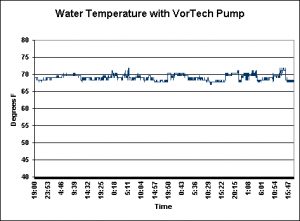
Figure 5. Temperature of 10 gallons (38 liters) of water with a MP10 running in maximum ‘Constant Speed’ mode over the course of 3 days (the pump was off for the first 24 hours). Even though the motor operates at a relatively high temperature, no clear trend of it increasing water temperature can be seen.
Power Consumption
On-going operational costs (such as the monthly power bill) are sometimes overlooked. The MP10 was tested for power consumption (as detailed in the Materials and Methods section, above). Figures 6 through 10 demonstrate the results.

Figure 6. Power Consumption (watts) of the MP10 in ‘Constant Speed’ mode. All are averages taken over the course of at least 20 hours.
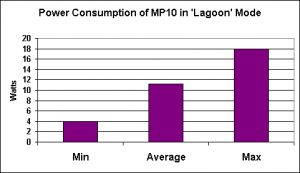
Figure 8. Power consumption when in ‘Lagoon’ Mode. Notice the average amount of work (water moved, as indicated by wattage) is higher than the Reef Crest Random mode!
Average Amount of Water Moved in Different Modes
If we know the amount of water moved by the pump at a given wattage, we can estimate the amount of water moved at the ‘average’ wattage of each mode.
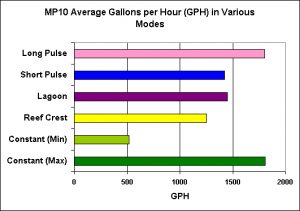
Figure 11. Volume of water moved by the MP10 in various modes. Surprisingly, the pump in ‘Lagoon’ mode pumps more water than when in the ‘Reef Crest’ mode.
Operational Noise
Noise can distract from the elegance of a well-maintained reef aquarium and, even worse, can make for some sleepless nights if the tank is in or near the bedroom.
The operation of the MP10 is not completely silent and the motor produces a slight whine as it ramps up and down (when in a mode that does so). However, I personally did not find this objectionable.
Noise at start up is not an issue since the current driving the pump is direct current (DC). Therefore, the pump spins in only one direction and the noisy chatter made by some propeller pumps driven by alternating current (AC) is eliminated.
Pump Footprint
The reduced size of the pump is advertised as an aesthetic plus. It is indeed smaller than most, if not all, internal pumps and/or powerheads.
See Figure 12 for a photographic comparison.
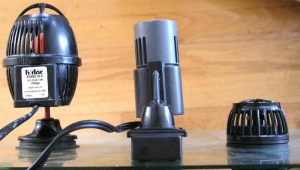
Figure 12. The MP10 (right) compared to other propeller pumps (Maxi-Jet modification (center) and Koralia 4 (left). All use magnets for positioning the pumps.
Other Considerations
The MP10 uses an axial shaft made of ceramic material. While ceramic shafts are inert in seawater and resistant to wear, they are brittle and subject to breakage due to mishandling during recommended periodic cleanings. Personally, I would prefer a rugged shaft made of high quality stainless steel.
EcoTech Marine warms of possible damage to the motor if it is dropped, and provides mounting tabs to prevent the motor from dropping should the magnetic coupling between the pump and motor be broken.
Aquarium sturdiness is yet another consideration. It is possible that harmonics of the moving water (especially in the Short Pulse Mode) could result in a wave traveling back and forth in the aquarium. Over a period of time, this could weaken the joints of an aquarium and result in failure. Sloshing could also be a concern.
Conclusions
In a day of product hype and hyperbole, it is refreshing to find a product that delivers more than it promises. Our testing found that the MP10 maximum flow rate exceeded the manufacturer’s claim, and all other advertising points were reasonable.
The MP10 outperforms many modified powerheads presently on the market, and it should – its purchase price is about 3 times that of other magnetically-mounted propeller pumps.
The controller offers flexibility and makes the pump suitable for a wide range of tank sizes and biotope mimicking. The controller/pump combination costs less than many of the programmable wave makers imported from Europe. Be aware that DC drive motors within an aquarium (and hence water-cooled) could transfer a considerable amount of heat to the ambient water.
The footprint (or size) of the MP10 is drastically smaller than other propeller pumps.
The surprise in the testing came with observations of water moved (based on power consumption). Reef crests are generally considered to be high-energy areas, yet the ‘Reef Crest’ mode ranks below ‘Lagoon’ mode under the conditions of our testing. This is not critical and merely a matter of semantics, as the MP10 offers enough options to create sufficient water motion.
Options
- Foam Intake Covers: This cover provides a couple of services – it keeps inquisitive fish from being pulled into the take, and lessens the chance of the pump being stalled by particulate intake.
- Battery Backup: Advertised to be an 18 Amp-hour battery, the manufacturer claims it will power a vortech pump for 30 hours or more. A trickle charger is included to ensure the battery stays charged for use during an emergency.
Suggested Manufacturer’s Retail Prices
This MP10 was obtained through normal retail channels. The price (plus shipping) was ~$195.00 US (~147 €). I found the prices of the battery backup and foam covers online, and they are $169.99 and $11.99 U.S., respectively. EcoTech Marine does not sell directly to the general public. Visit their website (listed below) for a listing of walk-in, online, and international vendors.
Warranty
EcoTech Marine warranties their product to be free from defects in material and workmanship for 1 year after date of purchase. Visit www.ecotechmarine.com for further details, warranty registration, and updates. Questions? Comments? Please contact me at [email protected].


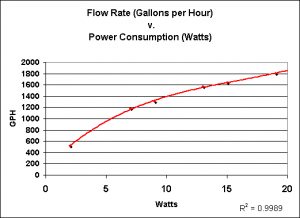
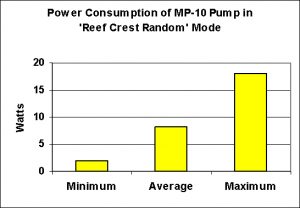
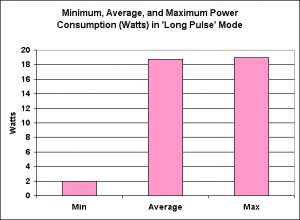
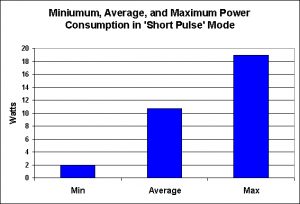

Thank you.
This is still useful for those of buying quality used aquarium equipment in 2023!